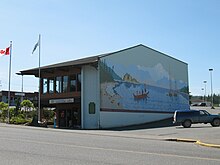Bear Cove

The Bear Bay (Engl. Bear Cove ) is an Archaeological Site in the Canadian province of British Columbia . According to the Borden system , it bears the signature EeSu-8 . It is located in the northeast of Vancouver Island not far from Port Hardy and contained the oldest evidence of human presence on the island. They are at least 4500, possibly up to 8000 years old. The artifacts are now in the Port Hardy Museum and Archives .
Excavation and meaning
The site is in a small bay near the Prince Rupert Ferry Dock . When this pier was to be built, the local Indians, the Kwakiutl , resisted the desecration of this important burial site and the endangerment of the oldest human artifact site on Vancouver Island.
A freshwater stream flows through the bay. Below a shell mound (shell midden), which is seven to nine meters above the present sea level at some distance from the beach, found a 1 to 1.5 m thick layer of organic remains in which there were no shells. At the bottom of this layer, C14 dating could be carried out, which resulted in an age of 8020 years with a deviation of 110 years. The lower layer of the mussel hill showed an age of around 4,300 years. Between the older shell-free layer and the shell mound there was a smeary, black layer 20 cm thick.
137 tools could be identified, 48% of which were rubble tools and 35 % chipping tools , projectile points machined on both sides made up around 6% of the finds, and tools of various kinds made up the remaining 11%. These include four hammerstones that were used to make tees , three notched stones and two pieces of bone or antler . Most of the tools are one-sided chopping tools or chopping tools . Overall, the artifacts were very similar to the Glenrose Cannery , an important site on the Fraser River in the Stó: lō area .
The animal remains are very different, however. Remains of marine mammals, birds, land mammals and fish could only be found in the black intermediate layer. 72% of the identifiable fish remains belonged to the rockfish ( Sebastes borealis ), salmon made up only 10%. In addition, there were small amounts of Pacific Cod ( Gadus macrocephalus ), which like its Atlantic relative, the cod , belongs to the cod ( Gadidae ), similar to the Pollack (pollock, probably the Pacific Pollack ), bullhead , green bodies , unspecified " dogfish ”and“ ratfish ”, fish populations that are still found in the region today.
The proportion of marine mammals was twice as high as that of fish. 78% of these could be assigned to five species. By far the largest share of porpoises ( Delphinidae , porpoise), only 9% were Northern Seebären (northern fur seal), 7% Steller sea lions (Steller Sea Lion), the remaining 4% were harbor seals and sea otters .
The 22% share that the land mammals represented was again mainly made up of mule deer , plus small amounts of dog Canis sp. and otters . In addition, birds such as ducks , seagulls, loons (called “loons” in North America) and guillemots were found . Elk is missing, but this is likely due to a lack of this species in the region.
Catherine Carlson assumed that it was a temporary, if re-used, warehouse, but the season of use could not be determined.
Despite the organic finds, the age can only be determined to at least 4500 BP . In any event, the hunting spectrum suggested the existence of watercraft and harpoon-like hunting weapons such as those found in Glenrose. The later coastal inhabitants, above all the Kwakwaka'wakw groups in the north and the Nuu-chah-nulth in the west of Vancouver Island, developed ocean-going watercraft, and to a lesser extent the coastal Salish .
See also
literature
- Catherine Carlson: The Early Component at Bear Cove , in: Canadian Journal of Archeology 3 (1979) 177-193.
- RG Matson: The Old Cordilleran Component at the Glenrose Cannery Site , in: Roy L. Carlson, Luke Robert Dalla Bona (Eds.): Early human occupation in British Columbia , University of British Columbia Press, 1996, pp. 111–122, here: p. 117 f.
Web links
Remarks
- ^ Catherine Carlson: The Early Component at Bear Cove , in: Canadian Journal of Archeology 3 (1979) 177-193, here: pp. 188 f.
Coordinates: 50 ° 43'25.9 " N , 127 ° 27'16.3" W.